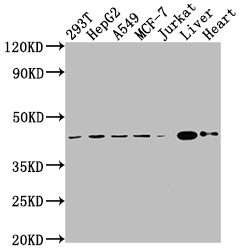The AGTR2 recombinant monoclonal antibody is produced using protein technology and DNA recombinant technology. Initially, a synthesized peptide derived from human AGTR2 was used to immunize mice, from which the spleen was isolated under aseptic conditions. The total RNA was extracted from the spleen cells and transcribed into cDNA, which was utilized as a template for PCR amplification of the AGTR2 antibody gene. The obtained gene was introduced into a vector, which was then transfected into host cells for culturing. The AGTR2 recombinant monoclonal antibody was extracted from the supernatant of the cell culture through affinity chromatography. It has been thoroughly verified and can be employed for human and mouse AGTR2 protein detection in ELISA and WB experiments.
The AGTR2 protein is a G protein-coupled receptor that is activated by the hormone Angiotensin II (Ang II), which is a key regulator of blood pressure and cardiovascular function. AGTR2 has also been implicated in the regulation of vascular tone, or the degree of constriction or relaxation of blood vessels, which is a key factor in the regulation of blood pressure. It modulates the activity of the renin-angiotensin system. It is believed to play a role in regulating blood pressure, fluid and electrolyte balance, and cell growth and differentiation. AGTR2 has been shown to have both anti-proliferative and pro-apoptotic effects.






